Streamlight make a wide range of lights which do not often grace the pages of CPF, but it is this wide variety that makes Streamlight an interesting manufacturer to look at.
Though Streamlight are not always leading the way with the latest LEDs, still use their proprietary 'C4' classification that covers many different LEDs that meet their own standard, and don't have the cleanest beams on the market, what they do do very well is to make versatile lights that do the job – As their trademark says 'Tools not Toys'.
There are a few different versions of the Knucklehead light with flood or spot beams. This review light is the rechargeable spot version with a far greater beam range than the flood version.
I can see where this light got its name. The articulated head does give an impression of a clenched fist, but the term 'knucklehead' is not the most favourable association. Would you be a 'knucklehead' if you buy this light, or will you have shown that you have your head on straight? – I suspect the latter.

Initial Impressions:
The Knucklehead Spot surprised me in just how substantial it is. A right angle head light (although the head is articulated) and a clip on the back made me think it would be something you could clip onto a shirt pocket. The Knucklehead however would most likely tear your pocket right off as it is a solid and weighs 655g
What is in the box:
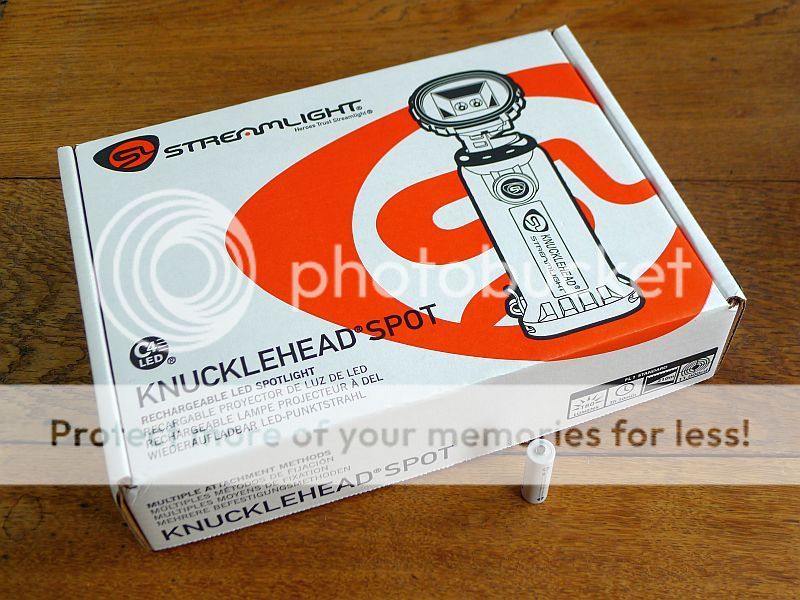
(Shown with AA battery for scale)
The first sight of the serious Knucklehead light
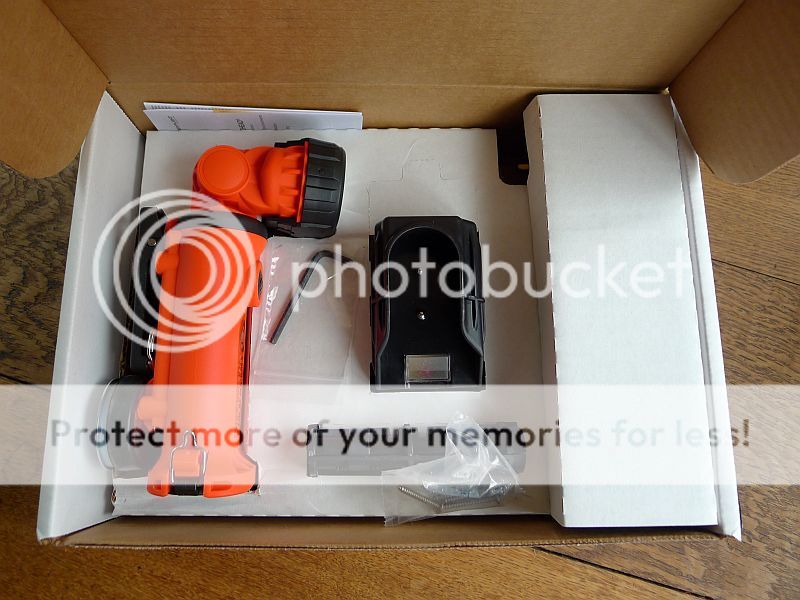
Included in the rechargeable kit is the Knucklehead Spot light, charger base, mains adapter, car adapter, AA battery pack, Allen key for the magnet and the instructions.
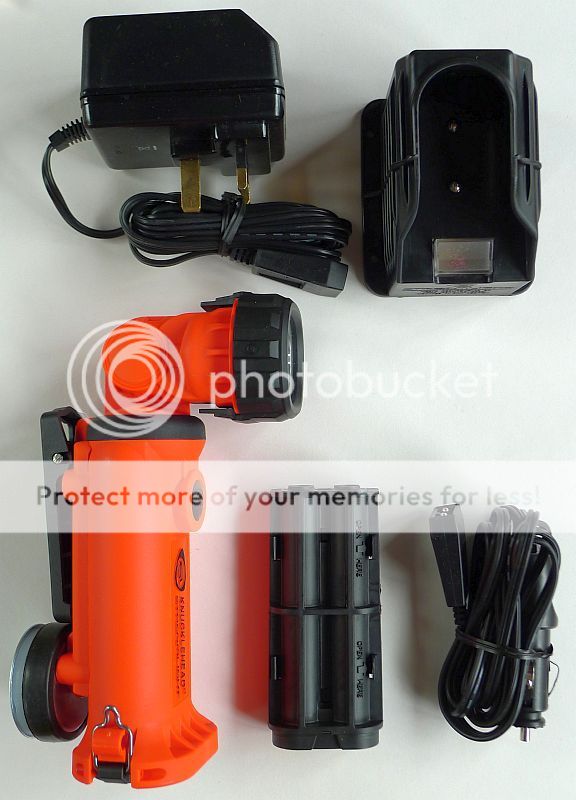
Taking a closer look and looking inside:
There are lots of functional details to look at on the Knucklehead. Starting with a look at the back of the light and the clip and magnet. The top of the clip has a lanyard loop, and the Knucklehead comes with a key ring which can be attached here to make a larger hanging loop.
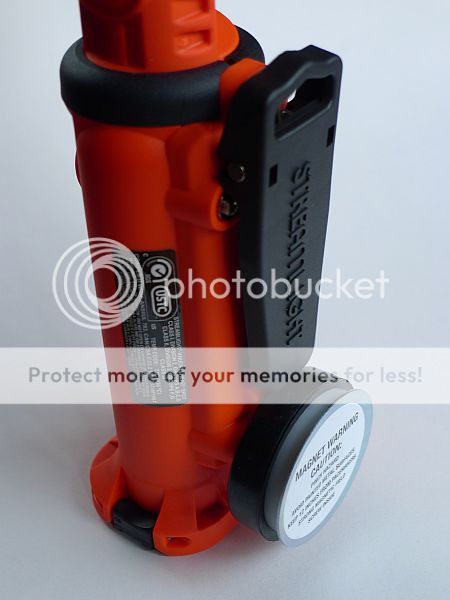
The magnet is removable, rubber coated and very strong. It comes with a plastic spacer and metal plate to 'cap off' the magnet. This prevent it from sticking to every bit of iron or steel it come anywhere near to and although described as something to discard, I have kept this to calm down the magnet until I want to unleash it.
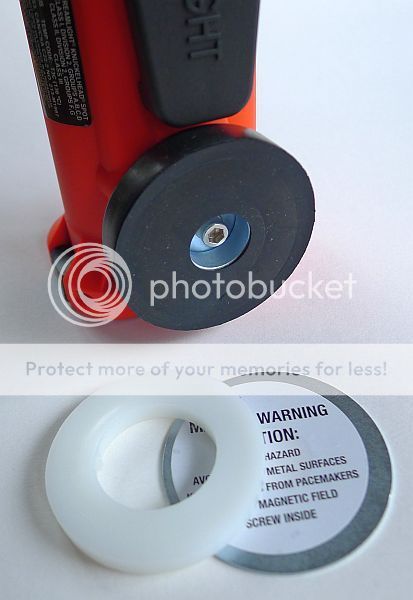
Looking side onto the clip and exposed magnet
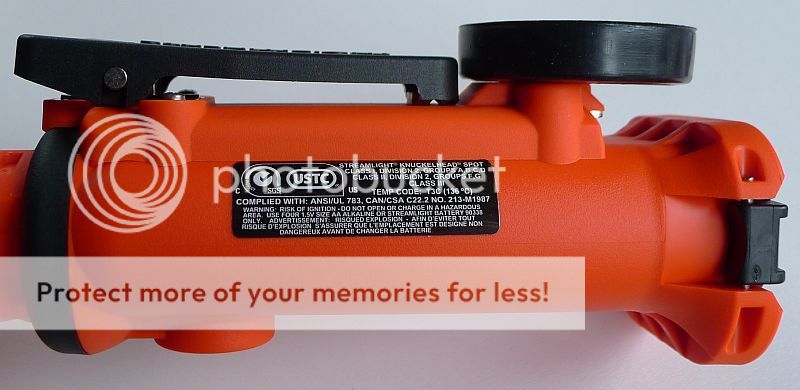
The label quotes all the standards the light has been tested to.
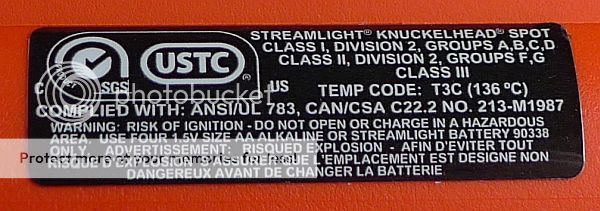
Looking at the base of the light shows the built in charger contacts used to recharge the battery pack.
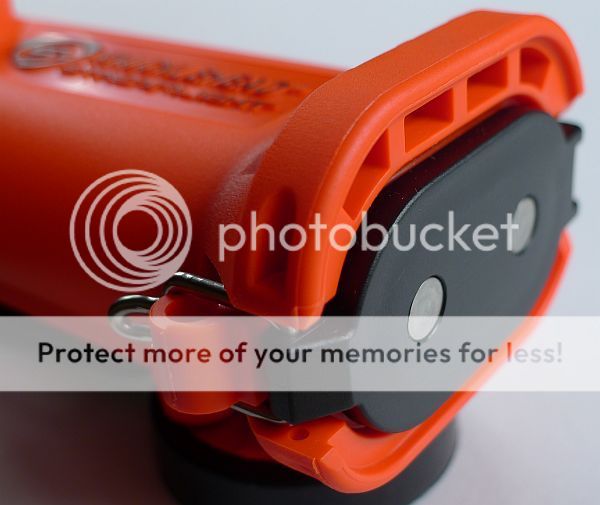
Opening the battery door exposes the o-ring seal and one end of the battery pack.
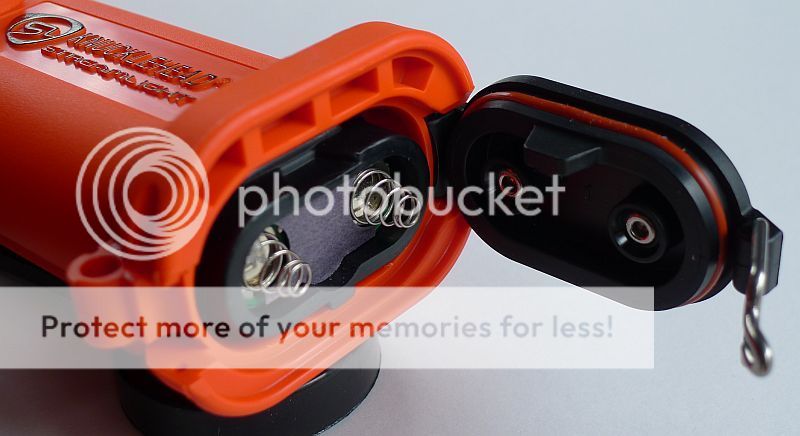
Taking the battery pack out shows the contacts used to power the light's driver board.
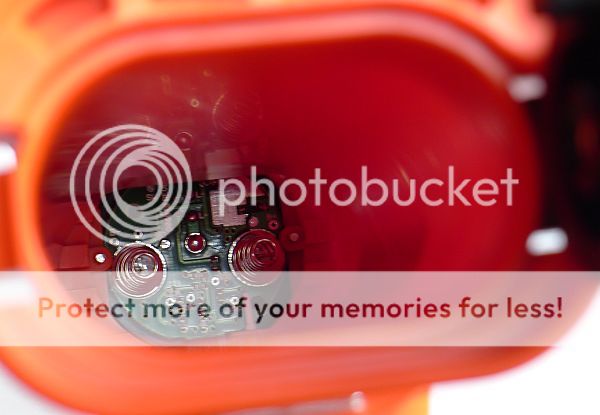
To ensure the battery pack polarity is correct a key system is incorporated in the design so the battery door will only close once the pack has been inserted the right way round. This is the same for the AA battery carrier.
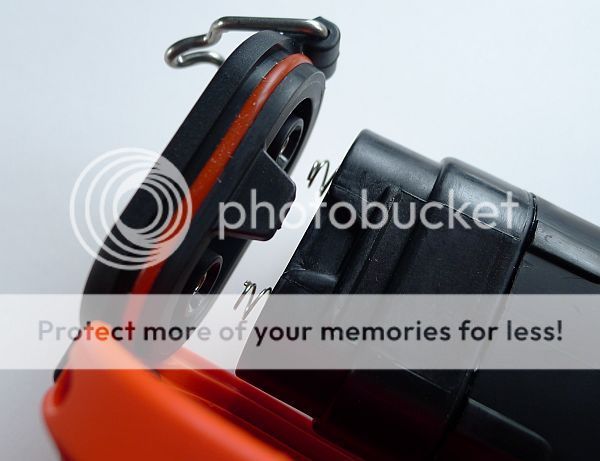
The 'C4' LED which looks like a CREE XP-G
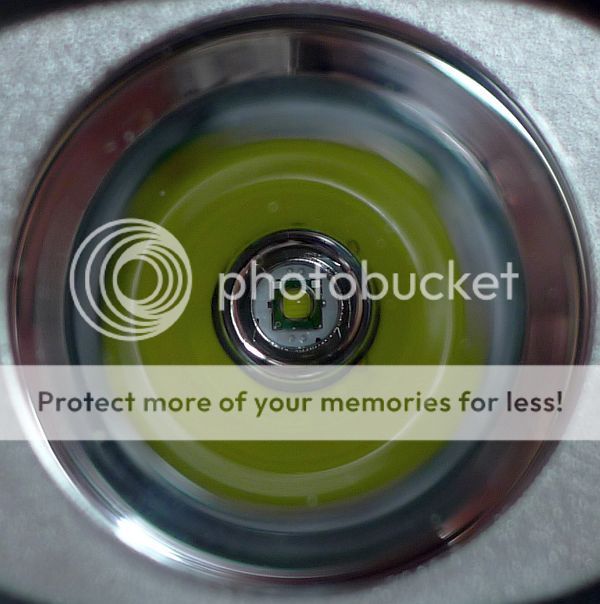
The reflector housing can hold the flood version with two LEDs and a textured reflector, or as shown here a single LED with deep reflector to provide a strong spot.
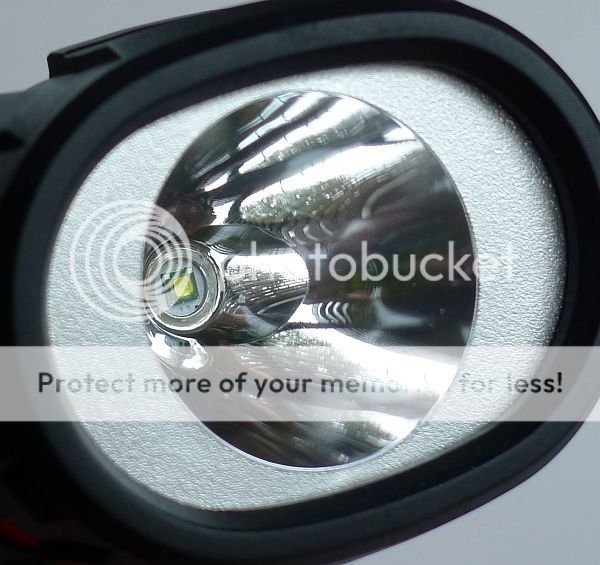
Modes and User Interface:
The Knucklehead's interface is very simple. It has a single electronic click switch interface with single click on to high, single click off.
However, to add to the versatility, if you hold the button down, after one second it drops from high to low, then after two seconds it enters strobe.
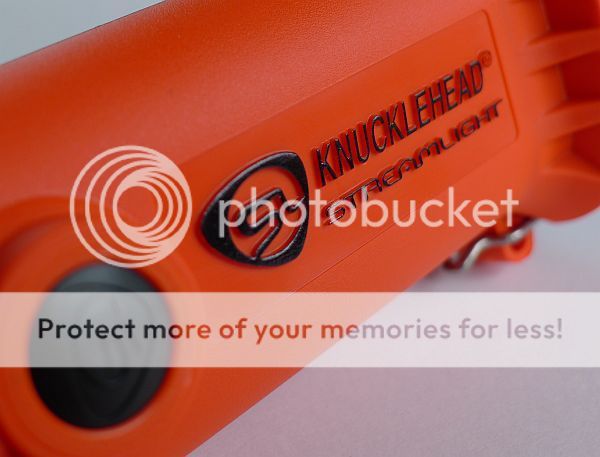
The Knuckehead lights also feature a moonlight mode for ultra-long runtime with very low output (no need to extol the virtues of moonlight mode here on CPF). To enter this mode you need to hold the switch for 8 seconds.
The LED on moonlight mode
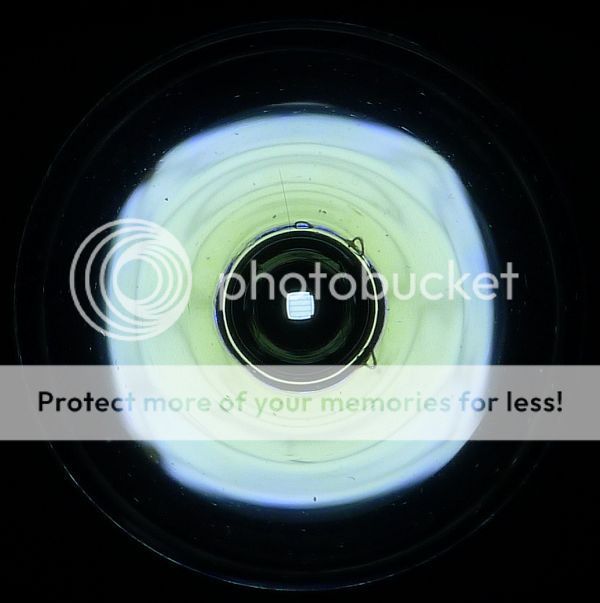
While on the subject of user interface, one of the special features of the Knucklehead is the fully articulated head. The joint shown here allows the head to pivot 210° and this also rotates 360° (in fact it does not have any stops so will turn unrestricted) as shown in image at the top of this review.
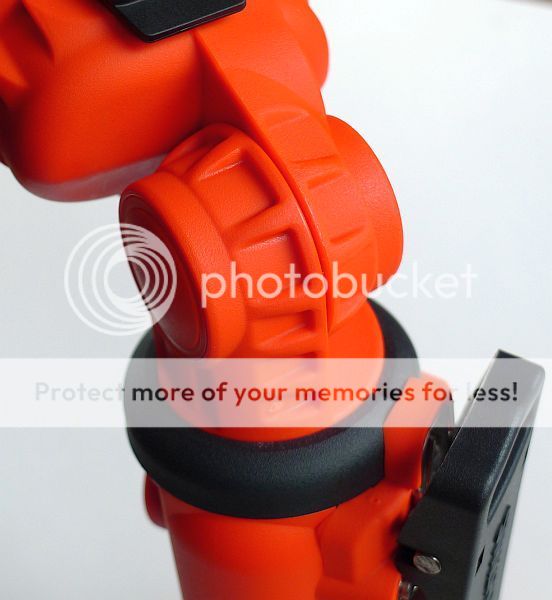
This really does support the Streamlight description of the Knucklehead as being 'Designed to put light where you need it'
Batteries and output:
The Knucklehead on test is the rechargeable version. The difference between this and the Alkaline version is that a rechargeable battery pack is included, as well as the slow charge base.
Slotted onto the charging base, the slow charger is a constant trickle charge type designed to be left on charge indefinitely.
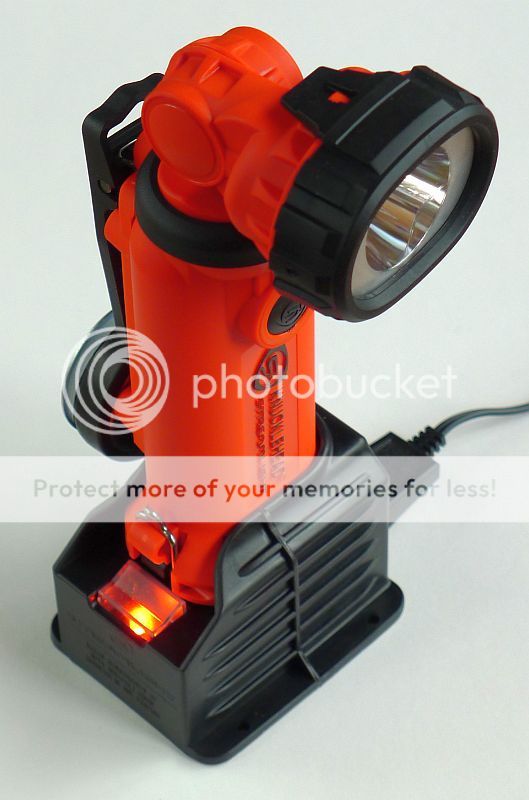
As well as the rechargeable battery pack, a standard AA battery carrier is included (and also available as an optional extra) which holds 4 AA Alkaline batteries. I have also run this light using Eneloops and during testing it worked perfectly on these batteries.
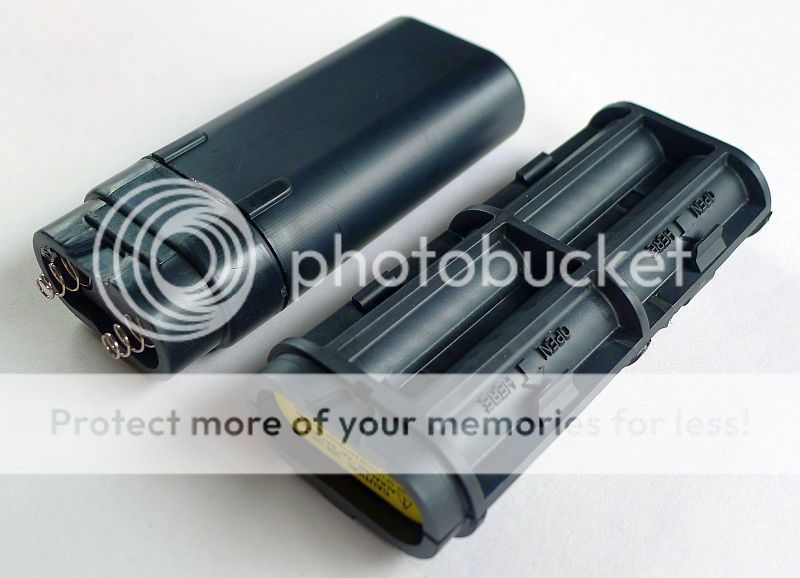
The battery carrier unclips allowing four standard AAs to be installed.
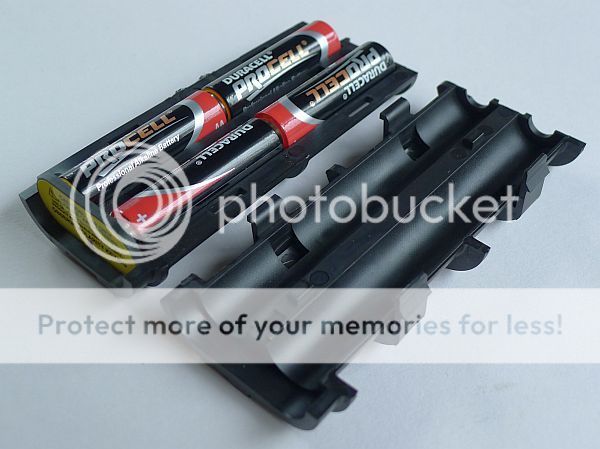
Like many lights, the Knucklehead has a parasitic drain due to its electronic switch (rather than a physical switch that cuts the circuit). I have not yet been able to measure this.
To measure actual output, I built an integrating sphere. See here for more detail. The sensor registers visible light only (so Infra-Red and Ultra-Violet will not be measured).
Please note, all quoted lumen figures are from a DIY integrating sphere, and according to ANSI standards. Although every effort is made to give as accurate a result as possible, they should be taken as an estimate only. The results can be used to compare outputs in this review and others I have published.
The Strobe runs at 2Hz
The Moonlight mode was below the integrating sphere's measurement range as the lowest output level that will register is 1.7lm. For this reason the quoted output level was <1.7lm.
In order to try to illustrate the Knucklehead's moonlight mode I use a Zebralight SC51 and Quark AA on their two lowest output modes.
First with the SC51 and Quark on their moonlight modes (both rated at 0.2lm)
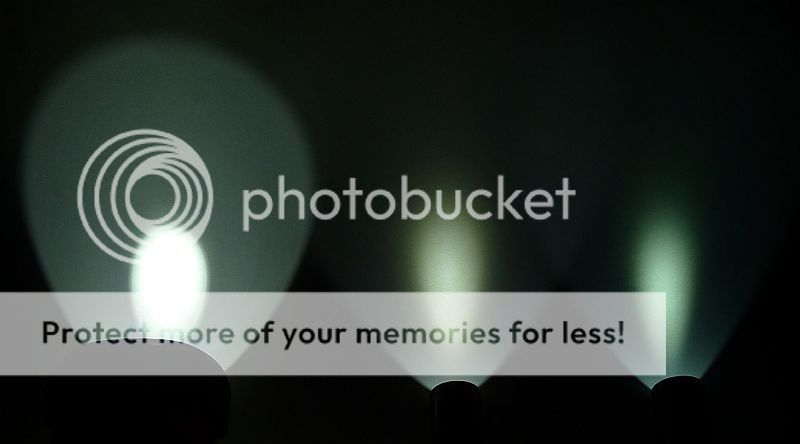
Then with the SC51 and Quark on low (2.5lm and 4lm respectively)
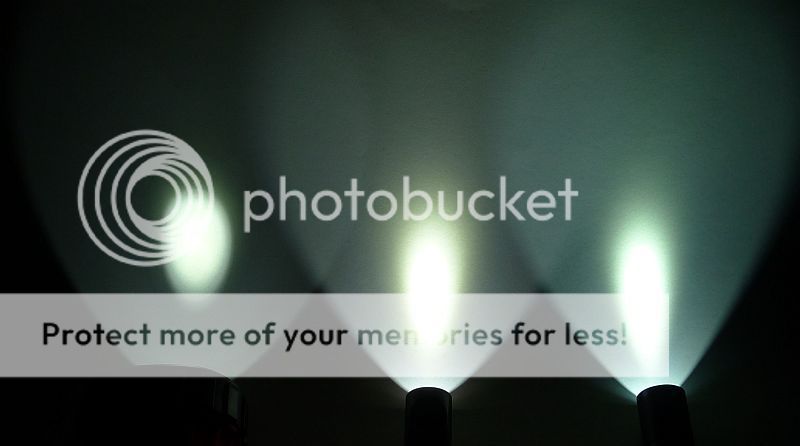
With the rechargeable battery fully charged the following output curve was achieved on high.
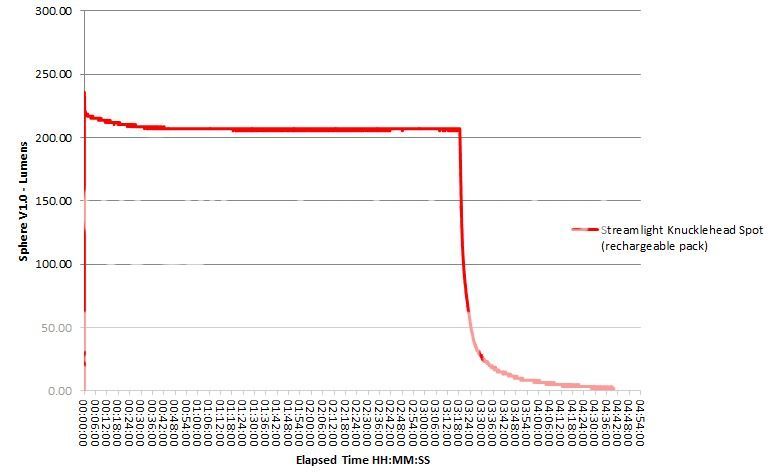
The output is well regulated and remains at a very consistent output level until the batteries are almost fully depleted. When the batteries get very low the output falls sharply but the output then just continues to dim gradually.
In The Lab
NEW for Winter 2012 ANSI standards include maximum beam range. This is the distance at which the intensity of light from an emitter falls to 0.25lux (roughly the same as the lux from a full moon). This standard refers only to the peak beam range (a one dimensional quantity), so I am expanding on this and applying the same methodology across the entire width of the beam. From this data it is possible to plot a two-dimensional 'beam range profile' diagram which represents the shape of the illuminated area.
In order to accurately capture this information a test rig was constructed which allows a lux meter to be positioned 1m from the lens and a series of readings to be taken at various angles out from the centre line of the beam. As the rig defines a quadrant of a circle with a radius of 1m, all the readings are taken 1m from the lens, so measuring the true spherical light intensity. The rig was designed to minimise its influence on the readings with baffles added to shield the lux meter from possible reflections off the support members.
The distance of 1m was chosen as at this distance 1lux = 1 candela and the maximum beam range is then calculated as the SQRT(Candela/0.25) for each angle of emission.
In this plot, the calculated ANSI beam ranges are plotted as if viewed from above (for some lights there may also be a side view produced) using a CAD package to give the precise 'shape' of the beam.
As these are the first few 'Beam Range Profiles' I have published there are no direct comparisons to reference lights as I still need to profile these.
Starting with the 5m range grid you get an idea of the local beam shape and strength with the spot punching through into the distance.
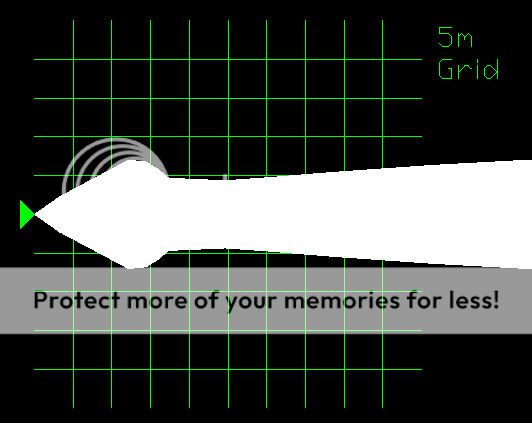
Then zooming out to the 50m range grid showing the extent of the beam's range.
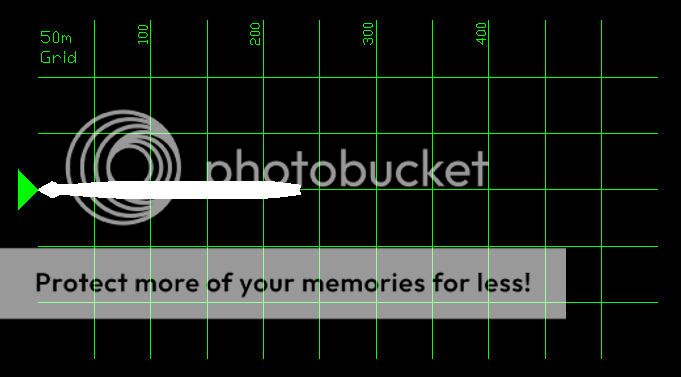
The beam
The Kuncklehead spot, unsurprisingly is a spot light, and the previous beam range plots clearly show the extended range of the beam.
The following beamshots show the light indoors with the strong spot very evident…
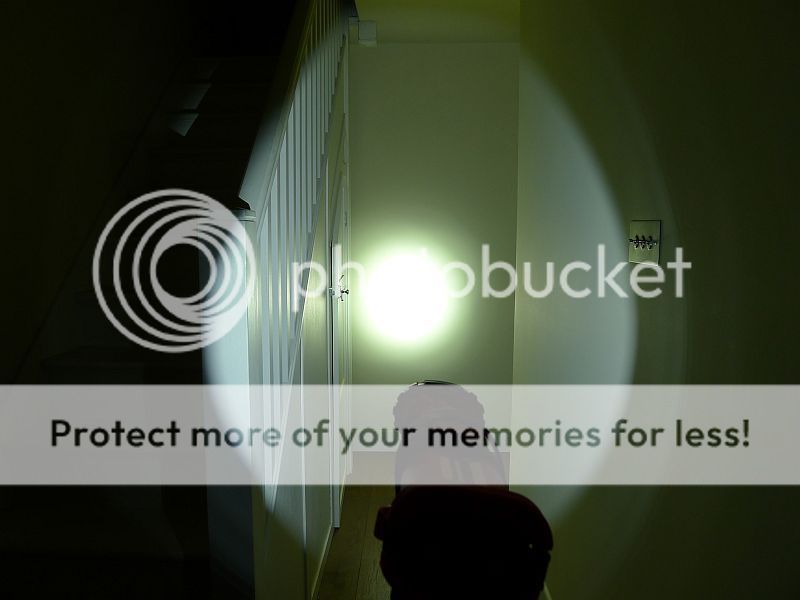
…and outdoors. In this photo the Knucklehead's magnet has been used to attach it to a round railing and was strong enough to keep the light firmly held vertically.
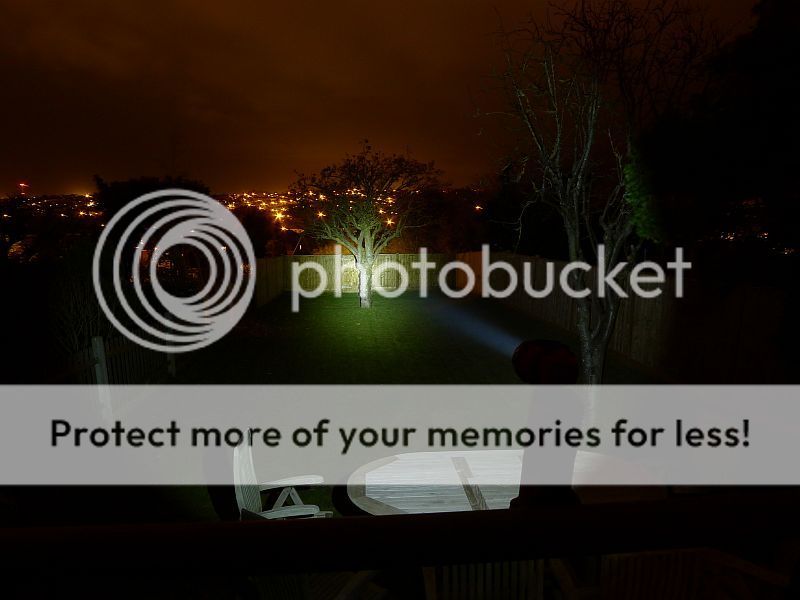
What it is really like to use…
With the choice of mounting options, the number of applications are innumerable and really only limited by what you can think of. This light is a tool, and the strong plastic casing makes it very robust and it should be able to easily shrug off any nocks.
In the previous outdoor beamshot, the light was attached to a metal railing using the magnet and the head easily adjusted and aimed at the tree.
The magnet is almost too strong, so you need to be careful when attaching or detaching it, but it does give you great flexibility for places to fix the light.
It may not have the brightest beam, but the versatile design allows you to easily illuminate your working space.
After the Knucklehead has been sitting on the slow charger for many hours, say over night, the body of the light appears to be warm to the touch. Concerned this was due to the battery pack overheating, I tracked it down to the charger base itself which gets quite warm, and it was this that had heated up the body of the light. Streamlight state that the slow charger can be used indefinitely and that it uses very little power. If the light is used for several hours daily, then I would agree, but for less frequent use I would not leave it on charge all the time as it seems too wasteful simply warming up the Knucklehead. If concerned about the battery running out, you can always have the AA battery pack loaded and ready to swap over if the rechargeable pack runs flat.
The Knucklehead is a bit chunky to comfortably use for longer periods as a hand held light, but this is not really its forte. This is really a portable work light and in this regard it excels.
With mains and 12v charger adaptors you can have it on charge and ready in your vehicle, home, utility room or workshop.
The Knucklehead really does put light where you need it. Whether you have a magnetic surface to attach it to, somewhere to clip it onto, or simply place it free standing on a table or the ground, the fully articulated head allows you to easily aim the beam of light.
Test sample provided by Streamlight for review.
Though Streamlight are not always leading the way with the latest LEDs, still use their proprietary 'C4' classification that covers many different LEDs that meet their own standard, and don't have the cleanest beams on the market, what they do do very well is to make versatile lights that do the job – As their trademark says 'Tools not Toys'.
There are a few different versions of the Knucklehead light with flood or spot beams. This review light is the rechargeable spot version with a far greater beam range than the flood version.
I can see where this light got its name. The articulated head does give an impression of a clenched fist, but the term 'knucklehead' is not the most favourable association. Would you be a 'knucklehead' if you buy this light, or will you have shown that you have your head on straight? – I suspect the latter.

Initial Impressions:
The Knucklehead Spot surprised me in just how substantial it is. A right angle head light (although the head is articulated) and a clip on the back made me think it would be something you could clip onto a shirt pocket. The Knucklehead however would most likely tear your pocket right off as it is a solid and weighs 655g
What is in the box:

(Shown with AA battery for scale)
The first sight of the serious Knucklehead light

Included in the rechargeable kit is the Knucklehead Spot light, charger base, mains adapter, car adapter, AA battery pack, Allen key for the magnet and the instructions.

Taking a closer look and looking inside:
There are lots of functional details to look at on the Knucklehead. Starting with a look at the back of the light and the clip and magnet. The top of the clip has a lanyard loop, and the Knucklehead comes with a key ring which can be attached here to make a larger hanging loop.

The magnet is removable, rubber coated and very strong. It comes with a plastic spacer and metal plate to 'cap off' the magnet. This prevent it from sticking to every bit of iron or steel it come anywhere near to and although described as something to discard, I have kept this to calm down the magnet until I want to unleash it.

Looking side onto the clip and exposed magnet

The label quotes all the standards the light has been tested to.

Looking at the base of the light shows the built in charger contacts used to recharge the battery pack.

Opening the battery door exposes the o-ring seal and one end of the battery pack.

Taking the battery pack out shows the contacts used to power the light's driver board.

To ensure the battery pack polarity is correct a key system is incorporated in the design so the battery door will only close once the pack has been inserted the right way round. This is the same for the AA battery carrier.

The 'C4' LED which looks like a CREE XP-G

The reflector housing can hold the flood version with two LEDs and a textured reflector, or as shown here a single LED with deep reflector to provide a strong spot.

Modes and User Interface:
The Knucklehead's interface is very simple. It has a single electronic click switch interface with single click on to high, single click off.
However, to add to the versatility, if you hold the button down, after one second it drops from high to low, then after two seconds it enters strobe.

The Knuckehead lights also feature a moonlight mode for ultra-long runtime with very low output (no need to extol the virtues of moonlight mode here on CPF). To enter this mode you need to hold the switch for 8 seconds.
The LED on moonlight mode

While on the subject of user interface, one of the special features of the Knucklehead is the fully articulated head. The joint shown here allows the head to pivot 210° and this also rotates 360° (in fact it does not have any stops so will turn unrestricted) as shown in image at the top of this review.

This really does support the Streamlight description of the Knucklehead as being 'Designed to put light where you need it'
Batteries and output:
The Knucklehead on test is the rechargeable version. The difference between this and the Alkaline version is that a rechargeable battery pack is included, as well as the slow charge base.
Slotted onto the charging base, the slow charger is a constant trickle charge type designed to be left on charge indefinitely.

As well as the rechargeable battery pack, a standard AA battery carrier is included (and also available as an optional extra) which holds 4 AA Alkaline batteries. I have also run this light using Eneloops and during testing it worked perfectly on these batteries.

The battery carrier unclips allowing four standard AAs to be installed.

Like many lights, the Knucklehead has a parasitic drain due to its electronic switch (rather than a physical switch that cuts the circuit). I have not yet been able to measure this.
To measure actual output, I built an integrating sphere. See here for more detail. The sensor registers visible light only (so Infra-Red and Ultra-Violet will not be measured).
Please note, all quoted lumen figures are from a DIY integrating sphere, and according to ANSI standards. Although every effort is made to give as accurate a result as possible, they should be taken as an estimate only. The results can be used to compare outputs in this review and others I have published.
| Streamlight Knucklehead Spot | I.S. measured ANSI output Lumens | PWM frequency (Hz) |
|---|---|---|
| High using included battery pack | 248 | N/A |
| Low | 58 | N/A |
| Moonlight | <1.7 | N/A |
The Strobe runs at 2Hz
The Moonlight mode was below the integrating sphere's measurement range as the lowest output level that will register is 1.7lm. For this reason the quoted output level was <1.7lm.
In order to try to illustrate the Knucklehead's moonlight mode I use a Zebralight SC51 and Quark AA on their two lowest output modes.
First with the SC51 and Quark on their moonlight modes (both rated at 0.2lm)

Then with the SC51 and Quark on low (2.5lm and 4lm respectively)

With the rechargeable battery fully charged the following output curve was achieved on high.

The output is well regulated and remains at a very consistent output level until the batteries are almost fully depleted. When the batteries get very low the output falls sharply but the output then just continues to dim gradually.
In The Lab
NEW for Winter 2012 ANSI standards include maximum beam range. This is the distance at which the intensity of light from an emitter falls to 0.25lux (roughly the same as the lux from a full moon). This standard refers only to the peak beam range (a one dimensional quantity), so I am expanding on this and applying the same methodology across the entire width of the beam. From this data it is possible to plot a two-dimensional 'beam range profile' diagram which represents the shape of the illuminated area.
In order to accurately capture this information a test rig was constructed which allows a lux meter to be positioned 1m from the lens and a series of readings to be taken at various angles out from the centre line of the beam. As the rig defines a quadrant of a circle with a radius of 1m, all the readings are taken 1m from the lens, so measuring the true spherical light intensity. The rig was designed to minimise its influence on the readings with baffles added to shield the lux meter from possible reflections off the support members.
The distance of 1m was chosen as at this distance 1lux = 1 candela and the maximum beam range is then calculated as the SQRT(Candela/0.25) for each angle of emission.
In this plot, the calculated ANSI beam ranges are plotted as if viewed from above (for some lights there may also be a side view produced) using a CAD package to give the precise 'shape' of the beam.
As these are the first few 'Beam Range Profiles' I have published there are no direct comparisons to reference lights as I still need to profile these.
Starting with the 5m range grid you get an idea of the local beam shape and strength with the spot punching through into the distance.

Then zooming out to the 50m range grid showing the extent of the beam's range.

The beam
The Kuncklehead spot, unsurprisingly is a spot light, and the previous beam range plots clearly show the extended range of the beam.
The following beamshots show the light indoors with the strong spot very evident…

…and outdoors. In this photo the Knucklehead's magnet has been used to attach it to a round railing and was strong enough to keep the light firmly held vertically.

What it is really like to use…
With the choice of mounting options, the number of applications are innumerable and really only limited by what you can think of. This light is a tool, and the strong plastic casing makes it very robust and it should be able to easily shrug off any nocks.
In the previous outdoor beamshot, the light was attached to a metal railing using the magnet and the head easily adjusted and aimed at the tree.
The magnet is almost too strong, so you need to be careful when attaching or detaching it, but it does give you great flexibility for places to fix the light.
It may not have the brightest beam, but the versatile design allows you to easily illuminate your working space.
After the Knucklehead has been sitting on the slow charger for many hours, say over night, the body of the light appears to be warm to the touch. Concerned this was due to the battery pack overheating, I tracked it down to the charger base itself which gets quite warm, and it was this that had heated up the body of the light. Streamlight state that the slow charger can be used indefinitely and that it uses very little power. If the light is used for several hours daily, then I would agree, but for less frequent use I would not leave it on charge all the time as it seems too wasteful simply warming up the Knucklehead. If concerned about the battery running out, you can always have the AA battery pack loaded and ready to swap over if the rechargeable pack runs flat.
The Knucklehead is a bit chunky to comfortably use for longer periods as a hand held light, but this is not really its forte. This is really a portable work light and in this regard it excels.
With mains and 12v charger adaptors you can have it on charge and ready in your vehicle, home, utility room or workshop.
The Knucklehead really does put light where you need it. Whether you have a magnetic surface to attach it to, somewhere to clip it onto, or simply place it free standing on a table or the ground, the fully articulated head allows you to easily aim the beam of light.
Test sample provided by Streamlight for review.

